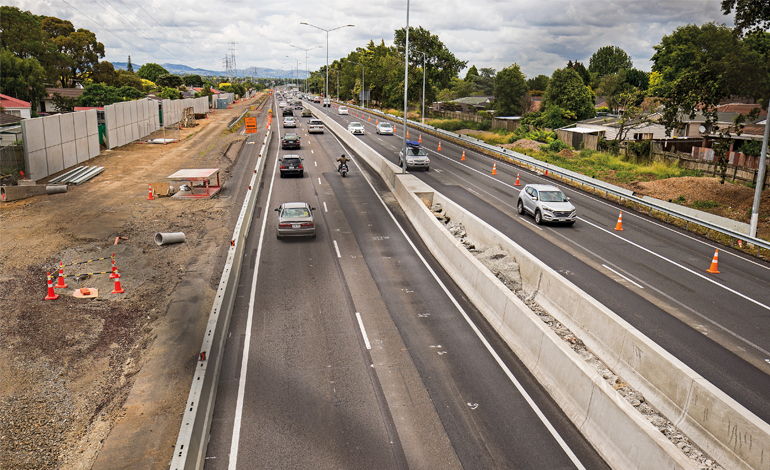By Wayne Scott, joint chief executive of the Aggregate and Quarry Association AQA and MinEx, the Mining/Extractives health and safety organisation.
We seem to like elections in this country. Two years out of three we go to the polls. Last year was the gap year – though a new Government was bedding in; this year, 2019 sees mayors and councils up for grabs.
Next year it’s the general election once again.
Industry bodies like the AQA and their members need effective working relationships with both central and local authorities.
This takes enormous effort but, in the last few months, the AQA has been rising to the challenge.
We had a year of change which has equipped us to engage better with the politicians and their officials in 2019.
At the annual QuarryNZ conference in July, Jared Johnston took over as AQA chair from Brian Roche, who remains on the AQA board.
There can’t be many national body chairs who are in their early thirties. Jared hails from a quarrying family and since leaving university with law and commerce degrees has rapidly progressed with major industry player, Fulton Hogan.
He is supported by the appointment of Mike Higgins as deputy chair. Mike’s 30 plus year history within the quarrying sector brings a tonne of real-life expertise, and he is currently Quarry Development manager for major central North Island company J Swap Contractors.
In September, long-serving AQA CEO Roger Parton retired. I had put to the AQA board my wish to continue as chief executive of the Mining/Extractives Health and Safety Council (MinEx), while also taking on the role as CE of AQA.
I can’t deny it’s a juggle, but with increasing office support and the retention of my central base within Wellington-based Straterra, I think I’ve been able to do justice to the dual roles.
My first AQA task was bringing together an eight-page briefing paper for Government, MPs and officials.
It’s the first such document since Foundations for our Future, produced 10 years ago. To be frank, the issues remain much the same: Our country uses around nine tonnes (one rigid truckload) of stone, gravel and sand per capita.
This is likely to grow with the coalition Government’s ambitious house-building plans, not to mention ongoing transport programmes. As an industry, we need continuity of supply from existing quarries and security of supply from future quarries.
As I write this I’ve just viewed a story about Templeton residents gearing up to fight a new quarry proposed by Fulton Hogan, one of our biggest and most responsible companies. The story includes drone footage which confirms there is barely a neighbour in distant sight of where the quarry would operate. The issue has gone from NIMBY – Not in My Backyard – to BANANA – Build Absolutely Nothing Anywhere Near Anybody.
My concern is this; are we going to become a BANANA republic?
Because if that is the case, then everyone had better adjust to steeply rising costs for homes, factories, offices, infrastructure and roading.
If quarries are pushed to remote rural areas, then the trucking component which form the bulk of the end price of aggregate, rock and sand will impact on every New Zealander. Big time.
Templeton residents have certainly heard from those living on the boundaries of quarries at Yaldhurst. I acknowledge those residents did face dust issues in the post-quake years. There was enormous pressure to provide supply for the rebuild and both the local and regional councils agreed existing quarries could push up production; issues with dust did arise – and the authorities took a long time to respond. When they did, some talked up Respirable Crystalline Silica (a real nasty) perhaps being present. Eventually the science proved it was not at any level for concern but silica is still being promoted as a fear at Templeton.
They have no need for such concerns. For one thing, quarries have lifted their game. The industry in Canterbury has established its own Code of Practice to set industry performance requirements. The councils will not want to again be at the centre of complaints about not managing dust, traffic and other issues pro-actively.
The AQA is also now working to get in front of such matters nationally. We’ve met in recent months with Housing/Transport/Urban Development Minister Phil Twyford and Infrastructure/Regional Development Minister Shane Jones.
We made the point that secure supply, quality of material and location are all important in the provision of quarry materials for affordable housing and infrastructure. We told the Ministers that quarry materials of suitable quality are not universally available and without good planning, access to resources will be compromised and costs and emissions will increase unnecessarily.
The AQA document informs the Ministers it would like the Coalition Government to give local authorities greater direction in planning for key resource areas, in order to protect existing quarries from encroachment of non-compatible land uses such as housing, and reduce reverse sensitivity potential.
It references possible directions under the Resource Management Act or Local Government Act, perhaps extending to a National Policy Statement.
We will continue to press these issues with the Government and officials.
Meanwhile, we are also engaging at a local level, with submissions to the Selwyn and Waikato district plans. Our resources don’t allow input to every one of the 50 plus district plans across the country, but we will work to provide template material.
What it may come back to is having local and central Government politicians who have an eye on more than the ballot box. Having local quarries may not be a vote-winner (any more than a local land fill, abbatoir, or cellphone tower)
Yet – each are fundamental contributors to the lives that we lead as New Zealanders. We cannot exist on Banana.


Parting words from Jeremy Sole- a final column